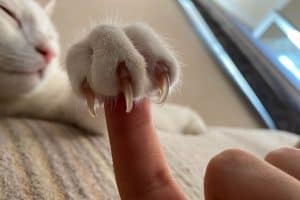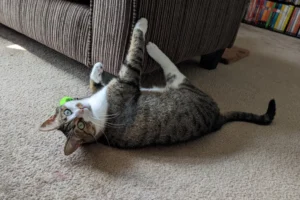Cats getting declawed is a controversial topic that sparks debate among pet owners and animal lovers alike. Many people wonder why this practice is common, while others vehemently oppose it. In this blog post, we will explore the reasons behind why cats get declawed and delve into the various perspectives surrounding this issue.
The Practice of Declawing Cats
Declawing cats is a surgical procedure that involves the amputation of the last bone of each toe. This procedure is often done to prevent cats from scratching furniture or people. While some people believe declawing is a quick fix for unwanted scratching behavior, it’s important to consider the potential risks and benefits.
One of the main risks of declawing is pain and discomfort for the cat. Imagine having the tips of your fingers amputated – that’s how a declawed cat feels. Behavioral issues, such as litter box avoidance, aggression, or depression, can also occur post-surgery.
Additionally, declawing can lead to long-term health problems, such as arthritis and lameness. On the flip side, some argue that declawing can prevent cats from being surrendered to shelters due to scratching issues. It’s crucial to weigh the pros and cons before deciding on this procedure.
Alternatives to Declawing
Instead of opting for declawing, there are several humane alternatives to prevent scratching behavior in cats. Providing scratching posts is a great way to redirect your cat’s scratching urges. Nail trimming is another effective method to keep your cat’s claws in check.
Behavior modification techniques can also help address scratching behavior. Training your cat to use scratching posts or deterring them from scratching furniture with double-sided tape or citrus sprays can be effective. Remember, consistency is key when implementing these alternatives.
For a comprehensive guide on cat scratching behavior and solutions, check out this helpful resource from the American Association of Feline Practitioners: AAFP Cat Scratching Behavior Guide
Legal and Ethical Considerations
Declawing cats is a hotly debated topic that raises important legal and ethical questions. In recent years, several states in the US have banned or restricted the practice of declawing, citing concerns about animal welfare and the potential for long-term negative effects on cats. Veterinary organizations, such as the American Veterinary Medical Association, have also issued guidelines discouraging declawing except in cases where it is deemed medically necessary. These developments highlight a growing recognition of the ethical considerations surrounding declawing and the importance of considering alternative strategies to address behavioral issues in cats.
Long-Term Effects on Cats
When it comes to declawing, it’s crucial to understand the potential long-term effects on cats. Beyond the immediate relief from scratching furniture, declawing can have lasting consequences for cats. Cats may experience changes in behavior, such as increased aggression or avoidance of the litter box. Mobility issues can also arise, as declawed cats may struggle to balance properly or jump onto surfaces. Additionally, many cats suffer from chronic pain after declawing, which can impact their overall quality of life. Considering these long-term effects is essential when deciding whether or not to declaw a cat.
- Consider Behavioral Changes: Declawing can lead to changes in a cat’s behavior, such as increased aggression or avoidance of the litter box.
- Mobility Concerns: Cats may struggle with mobility issues post-declawing, affecting their ability to balance or jump onto surfaces.
- Chronic Pain: Many declawed cats experience chronic pain, impacting their overall quality of life.
For more information on the potential long-term effects of declawing on cats, you can refer to the American Association of Feline Practitioners’ guidelines on feline onychectomy.
Declawing Myths vs. Facts
Contrary to popular belief, declawing is not just a simple nail trim for cats. It actually involves the amputation of the last bone of each toe. This procedure can lead to long-term physical and psychological issues for your feline friend. Myth: Declawing is a quick fix for scratching problems. Fact: Scratching is a natural behavior for cats, and declawing can result in pain, infection, and behavior changes. It’s vital to provide alternative scratching surfaces and training for your cat instead.
Veterinarian Perspectives
Veterinarians overwhelmingly discourage declawing due to the associated risks and harm it can cause to cats. Dr. Smith from the American Veterinary Medical Association emphasizes that declawing is a major surgery with significant consequences for a cat’s well-being. Recommendation: If scratching is a concern, consider trimming your cat’s nails regularly, providing scratching posts, and using nail caps as safe alternatives.
- Insightful Tip: Dr. Jones suggests behavioral modification as a first step before considering declawing. Positive reinforcement and training can often address scratching issues effectively without resorting to surgery.
Remember, understanding the true implications of declawing is crucial for the health and happiness of your beloved feline companion.
Cat Owner Experiences
Throughout various real-life stories shared by cat owners, a common theme emerges – the decision to declaw a cat is often made out of a desire to protect furniture and prevent scratching-related behavior issues. However, many owners have reported negative consequences of declawing, such as chronic pain, changes in behavior, and difficulty using the litter box. One cat owner, Sarah, shared her experience of regretting the decision to declaw her cat after seeing the negative impact it had on her feline companion’s well-being. This highlights the importance of considering alternative methods, such as providing scratching posts and regular nail trimming, to address scratching behavior while preserving the cat’s health and natural instincts.
The Importance of Informed Decision-Making
When it comes to deciding whether to declaw a cat, it’s crucial for cat owners to arm themselves with knowledge and weigh all options carefully. Declawing, also known as onychectomy, is a surgical procedure that involves the amputation of a cat’s toes up to the first joint. This process can lead to long-term physical and emotional consequences for the cat. By understanding the potential risks and complications associated with declawing, cat owners can make informed decisions that prioritize the well-being and quality of life of their feline companions. It’s essential to consult with a veterinarian and explore alternative methods of managing scratching behavior before resorting to declawing.
Additional Tip: Consider investing in soft nail caps for your cat as a safe and humane alternative to declawing. These caps are applied to the cat’s claws to prevent damage from scratching while allowing them to exhibit natural scratching behaviors without causing harm.
Alex, a passionate animal lover, has experience in training and understanding animal behavior. As a proud pet parent to two dogs and three cats, he founded AnimalReport.net to share insights from animal experts and expand his knowledge of the animal kingdom.




